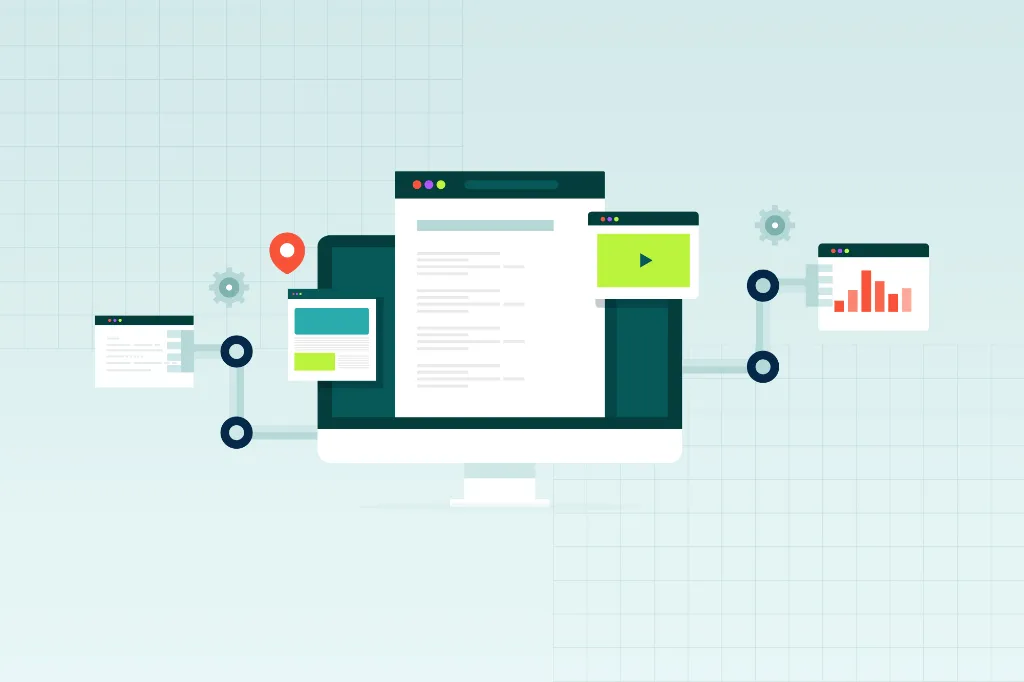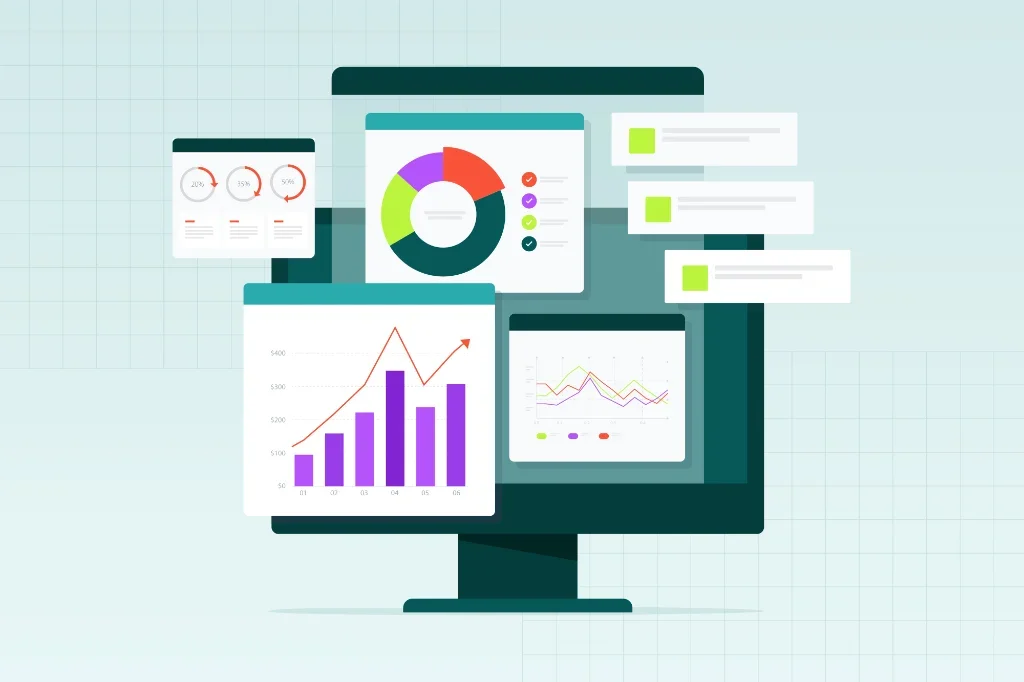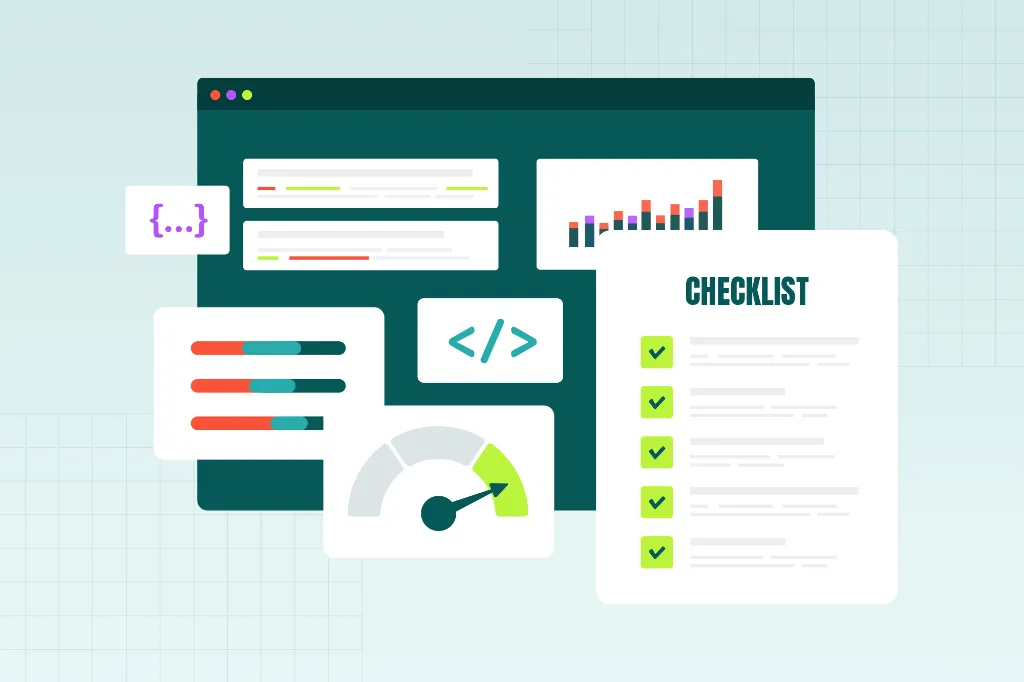Automation isn’t on its way. It’s already here, running the show. It powers our marketing emails, tracks every click on social media, and even lets us skip the checkout line at the grocery store. And in SEO? It’s no longer just about pulling a quick keyword report. When I sat down with Enterprise SEO Strategist Nick Fatigato, we dove into how automation is transforming the SEO game by making it faster, smarter, and impossible to ignore.
“Today’s SEO landscape demands the speed, scale and precision that many available automation tools provide.”
SEO Turning More to Automation
Automation is now the norm, freeing teams for strategy, analysis, and creative work. It handles weekly site crawls, metadata generation, and reporting.
Automation-friendly tasks include:
- Technical SEO audits (Screaming Frog, Sitebulb)
- Rank tracking and performance reporting (Semrush, Ahrefs, Google Looker Studio)
- Internal linking suggestions (Link Whisper, Surfer SEO)
- Bulk metadata generation using templates or AI
- Broken link detection and monitoring
- Scheduled crawls and change monitoring
Human judgment still matters, so be sure to review the data in the reports to see that it’s accurate and doesn’t contain errors. Automation should support analysis and your work, not replace you. Critical thinking and brand familiarity beat tools for interpretation.
Is Automation the Future of SEO?
Automation is already shaping the present, not just the future. To stay competitive, learn how AI tools such as ChatGPT, Perplexity, and Claude work and discover new ways to use them in daily tasks.
AI and automation are often treated as synonymous, but they are not one and the same. To differentiate between AI and automation, consider their roles.
- AI = on-demand assistant for tasks such as generating blog ideas or providing research insights
- Automation = manually setting up processes that run on recurring schedules without needing repeated input
- AI can inform and guide automation setup, but automation requires predefined workflows.
Automation for SEO is more than just strategy. It’s about executing at speed, scale, and accuracy.
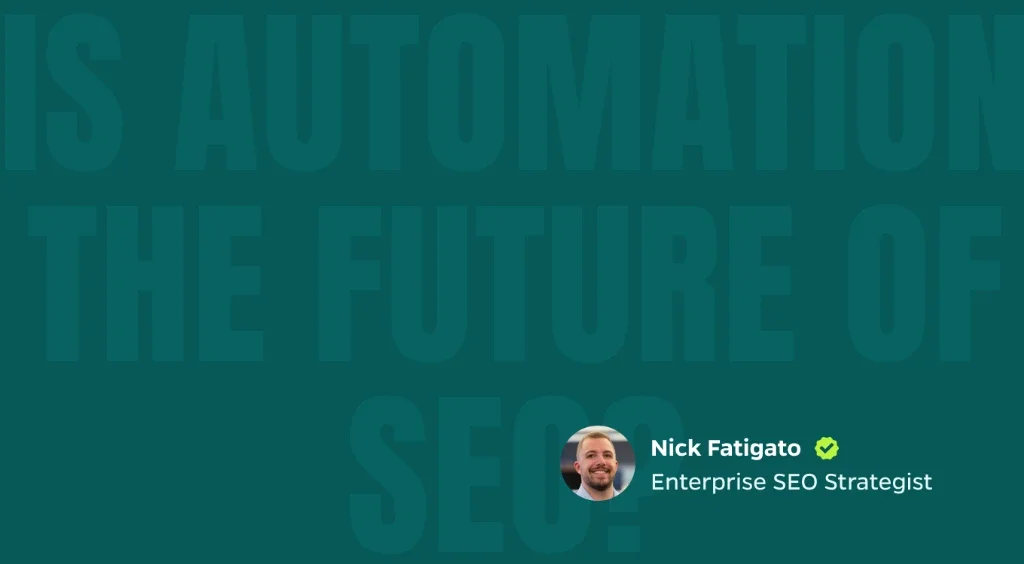
Is Automation the Future of SEO?
It’s a great question, too. SEO, right now is rapidly changing. We’ve seen it so much with the AI landscape and ChatGPT. Google’s own AIOs showing up in search and just endless tools, AI, tools that are emerging every day, and new ways for people to kind of tackle their work and their websites. So I think it’s certainly the future. And it’s also the present. We need to be flexible and understand what tools are available for us. How can we use these AI tools or platforms like ChatGPT, Perplexity, Claude to improve what we’re doing right now without completely just taking a back seat and letting it do everything themselves? I think that we understand as humans that we can’t just press a button, and a robot will do our entire job for us. That’s not the point of automation tools necessarily right now. The point is to help you assist you and make you more efficient, because that’s the industry that we’re in right now. So it’s certainly the future. But it’s also the now. And the now aspect is learning about these things and making sure that you’re not just kind of being left in the dust. You want to make sure that you’re at the forefront of these, you know the industry and at the forefront of the tools that are available to you, because if you’re not using them, someone else is going to be using them and it’s important to know the best way to use those tools. And like we’re talking about, not to abuse them and not to just replace your you know all of your thinking yourself, but it’s certainly where we’re going, and I think everyone’s aware of that. It’s just a matter of how much buy-in do you have right now? Because eventually you’re going to be forced to buy into working this way. It just seems to be not just our industry, but the way of the world.
SEO Tasks to Automate
Think about your website goals. What are you trying to achieve, and which processes could you assign to collect the right data? If you’re starting out, technical audits are a smart first step even though they can be time-consuming.
Tools like Screaming Frog or Sitebulb can crawl your site on-demand and be scheduled at set intervals. They help you track 404 errors, missing pages in XML sitemaps, and other issues. Running audits regularly keeps problems in check and reduces errors over time.
For reporting, use Google Looker Studio, Search Console, or paid tools like Semrush and Ahrefs to automate performance dashboards. These make it easier to spot trends, analyze data, and adjust content as needed.
Exploring the Tools for Automating SEO
Searching for the right tool for automating SEO may overwhelm you with options. Here are just a few and how they can help your workflow.
Category | Tools | Description |
Technical Audits | Screaming Frog, Sitebulb | Both tools crawl a website and extract technical data in the background, including HTML code, JavaScript, XML sitemaps, status codes, and redirects. |
Reporting + Analytics | Google Looker Studio | Integrates with Google tools (Analytics, Search Console, Sheets, APIs) to create dynamic dashboards. Automates reports, tracks rankings, impressions, clicks, and allows filtering by date ranges. Data can be exported or scheduled for delivery. |
SEO Reporting | Semrush, Ahrefs, Moz, BrightEdge | Provide performance analysis for your domain and specific pages. You can also enter a competitor’s website or URL for research. These tools support content planning and topic ideation. |
AI Platforms | ChatGPT, Perplexity, Claude | AI tools that can be customized for specific needs, including preparing content for editorial review, conducting technical analysis or development work, and performing broader organic research. |
These tools can provide great support for task-based work, but it takes human brainpower to break down the data, analyze it, and apply it to fit the company’s strategy.
Automation is not a replacement for strategic thinking. Every company wants to do things faster and more efficiently. It starts with building a team of experts in different areas of the business. Setting up and automating tasks can assist in streamlining some of the tedious tasks. The expert still needs to be in the driver’s seat. You don’t want the automation tools in complete control of your campaigns, as you are more familiar with the tone, brand, financials, and other intimate details of the business. It’s important not to lean too heavily on the tools.
Risks That Come With Over-Automating
It’s not that it’s too good to be true. It’s that it’s new. Because of its newness, it’s not going to be right 100% of the time. The biggest mistake users can make is to set it and forget it. With AI and automated tools, it’s crucial to go in and check the output to confirm it makes sense and isn’t not full of errors.
Ask yourself:
- Does it reflect what you would normally produce yourself if you were doing the whole task yourself?
- Does this work for the client?
- Would I publish this on my own website?
Critical thinking matters. Automated work must be high-quality, accurate, and aligned with your brand. This applies to writing, keywords, and content in general. If all your content is automated, Google will know. To connect with both your audience and search engines, your personal touch and direction are vital.
“So I would say, whenever you’re automating something, or whenever you’re using any of these tools, always look at what you’re putting in and what you’re getting out, and if it’s not, you know, up to the standard, you think it should be either make adjustments or pivot over to going back to a more manual process, or just finding a different tool that maybe can do it better.”
When Not to Automate
Two things should never be automated: strategy and content. Content remains Google’s top priority, especially when it reflects the E-E-A-T principles: experience, expertise, authority, and trustworthiness. At the core of these principles is the human element. While AI tools can gather information quickly, they lack the real-world insight and intelligence you bring from working in an industry or with clients. AI also relies on existing data, meaning it may miss emerging trends you’re aware of, giving you the chance to demonstrate true authority. Google has been prioritizing this human-driven expertise for some time.
Other Tasks That Suffer When Automated
Some tasks should remain manual or semi-manual for the best results. These include the following:
- Content strategy and topic ideation
- Editorial content writing and editing (AI-assisted ≠ AI-only)
- Link building outreach and relationship building
- E-E-A-T assessments (experience, expertise, authority, trust)
- Brand voice and tone enforcement in on-page copy
- Search intent evaluation and SERP feature analysis
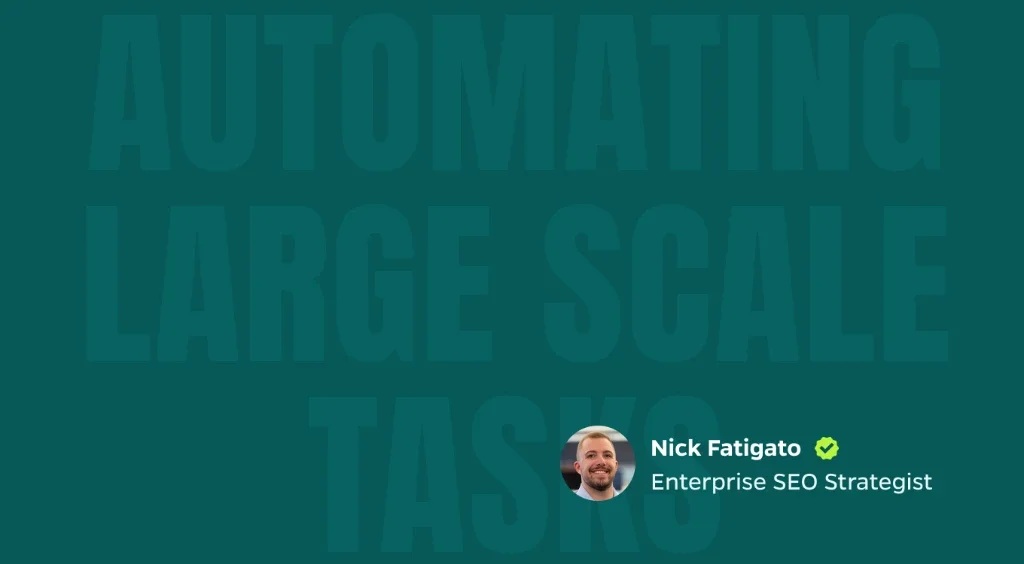
Automating Large Scale Tasks
I would say another one is metadata and title tags, meta descriptions, and scaling those. So I think I mentioned this the beginning of the call. But say, you’re an e-commerce website, and you have a thousand pages that you want to update title tags for. There are tools, and even using something as simple as you know, Excel spreadsheet where you can use formulas to maybe plug in a certain phrase, and then it auto fills, just replacing a certain word within each one. So that’s something that can be automated. But also, when you’re working on tons and tons of pages like that at one time, you want to make sure that you’re reviewing it as well, just even if it’s like overall view. Because when you’re putting that many things through an automation tool, it’s possible that there are mistakes or something didn’t get done the way you thought it might be done. So anything that’s being done at really large scale, like generating keywords or updating the metadata for every single page, I think it’s really important to automate those tests as much as you can. But once again, you know, should always still have that review, so you’re not going back and trying to fix problems because you didn’t check that initially.
Once you are more familiar overall with your audience and your industry, you can look at ways to pull in the automation tools to help you pull additional information. Then you can prompt it, call out trending items, and give it more direction. It can expand on what you already know.
The Gray Area: Tasks You Can Automate, But Maybe Shouldn’t Fully
Everyone is fighting for visibility on Google, but overusing AI content risks both rankings and credibility. Google can detect pages that lack authority, unique voice, or substance. As ranking signals evolve, expertise matters more than ever.
Ask yourself: How long have you been in this field? What insights can you share that AI can’t? Personal experiences, customer testimonials, and real-world anecdotes reinforce authenticity. The key is blending AI assistance with genuine human input to protect both authority and voice in SEO.
Taking a Hybrid Approach to Content
When drafting a blog post, you might start with a 500-word piece based on your expertise. Once it’s complete, AI tools like ChatGPT can help by checking grammar, spotting gaps, comparing against competitors, and suggesting improvements.
“Having an anecdote, real-life example, or verified data from trusted sources tied into your blog post could have a lot of value. It shows to Google, AI platforms and users that you have a clear experience with this, and you’re an expert.”
This approach is especially valuable when you’re exploring a new industry. AI can quickly provide research and insights, helping you write more accurately in areas where your expertise may not be as deep. But while automation can save time, it’s important to balance it with a human touch.
For example, you can:
- Use AI to generate keyword variations, then manually prioritize them.
- Automate content briefs, while editing them for tone and accuracy.
- Scale title tags and meta descriptions with templates, then refine them manually.
- Automate schema markup generation, while reviewing for correctness.
The key is to use AI as an enhancer, not a replacement, so your unique voice isn’t lost. These tools are particularly useful for editing, filling gaps, or boosting SEO focus.
Going back to the blog post, you could put your draft into an AI tool and have it:
- Scan for keyword usage and highlight frequency.
- Identify the major themes and point out what’s missing.
- Confirm that it aligns with your target audience.
- Ensure it meets the right word count.
By setting clear parameters, automation helps elevate what you’ve already created. You can take your blog post to the next level while keeping it authentically yours.
Balancing Efficiency and Authenticity
Do you understand your website’s audience and what those potential customers want? Knowing their interests, challenges, and industry trends is key. It’s something automation tools like ChatGPT can’t fully grasp. Your expertise brings the personal touch and critical thinking that SEO needs, keeping content relevant and authentic.
“People are getting information without even clicking on websites more often than ever before. It’s important to understand your audience. Write content that makes sense for them. And I think that’s where the overall balance comes in for all tasks, not just content.”
Adding Guardrails to Automation
Start with realistic expectations. Think about the tasks that you do daily, and which take up the most of your time. Then, create a matrix or outline. Find the biggest challenges in your workflow and look at ways to streamline those processes and make them more efficient. It helps, too, to have a foundational mindset as a company so you don’t try to automate things that need more critical thinking.
When you are ready to dive in fully, you’ll need the right tools to help.
Setting Up Your SEO Automation Toolbelt
Start from the ground up with a full website audit. Review your content structure, evaluate technical performance, and identify areas for improvement. Then, map out where you want your site to be in the next 12 to 18 months and outline the steps to get there.
As part of this process, consider how automation tools and third-party software can streamline your work. These should be key parts of your toolkit, especially for technical audits. SEO tools can help optimize reporting and keep your website running like a well-oiled machine.
Add These Tools to Your Automation Toolbelt
The industry for automation tools continues to grow at a rapid pace with new AI content tools coming out daily. Think about the tools you already have and what would help you build your automation program. Conduct due diligence and talk with the team to ensure that it works for everyone. Ask the following questions:
- Is the platform scalable?
- Does it fit your needs?
- Are you a small business that can handle some minor touchups?
- Do you need content at scale, producing 50 different pieces per month?
These tools also need to provide accuracy in data for your team.
“And I’ve mentioned this before, but I do think it’s super important. If you are using a platform to create your content — or help you generate briefs of your content — make sure you go back and say: ‘Where can we insert our voice, and where can we insert our expertise that our audience would understand and value, and ultimately lead them to trust us more.’”
Automating Off-Site SEO Is Possible
Off-site SEO is about relationship-building, link-building, and getting your content published on other sites. While it is a tougher thing to automate, it is possible.
Step 1 (manual): Build authority in Google searches by publishing external links on relevant websites that meet the E-E-A-T standards. Find a website where you’d like your content published, then check for a contact there to discuss adding guest posts to the site.
Step 2 (automated): Create email templates you can use to reach out to the contacts that you’ve found who can help get your guest post on those websites you found.
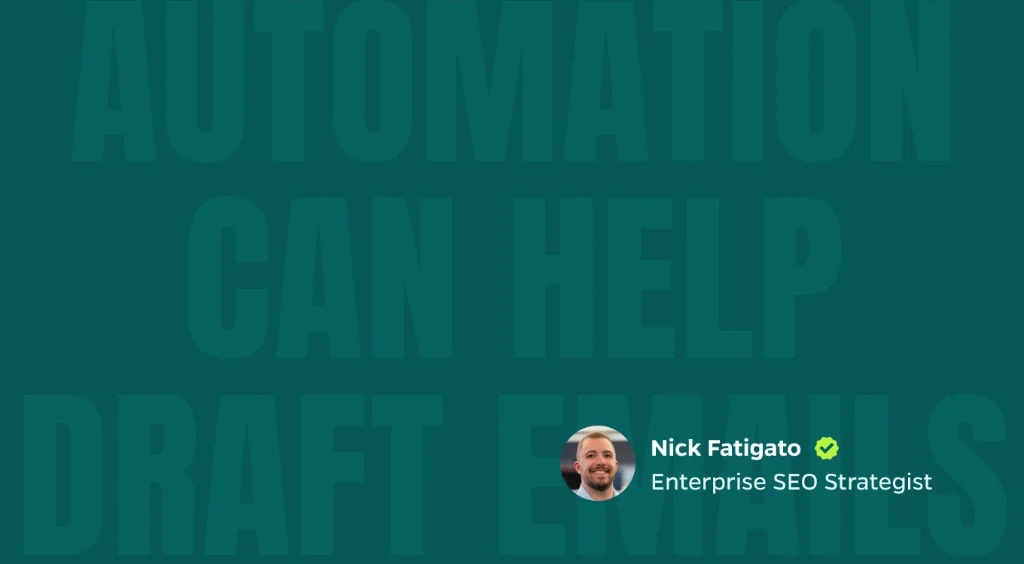
Automation Can Help Draft Emails
So instead of crafting 50 different emails to 50 different websites, you can kind of use a tool, even something like ChatGPT to say, “Hey, I need a prompt, for, you know, reaching out to somebody on an external website. But I need to write it for this industry, and then I need to write it for this industry.” So you can have different tool build that template for you, maybe have some sort of structure, or some sort of kind of example to feed to a tool like ChatGPT. But then you don’t have to actually sit there and write the email 50 different ways. You can have a tool automate that process for you.
The more content you get off-site, the more opportunities you have for Google and other search engines to confirm your authority. Large language models (LLMs) can only pull information that they know and that’s based on the content on your website and others, so this is a great step to take to keep putting your brand out further than your own site.
SEO Signals That Matter for Off-Site
When you establish who you are as a business and then include that in your off-site messaging, it sends signals to SEO that your brand is aligned with your messaging. Search engines and LLMs have the same basis at the root of their algorithms.
- What do we know about this topic?
- What do other websites say about this topic?
- How can we connect the dots?
- What websites do we assign authority to (e.g., Wikipedia)?
- Which websites do we know are trustworthy?
One of the strongest off-site SEO signals for Google is when your work is published on external websites and properly cited, demonstrating your expertise on a topic. Google can then discover the content, follow the link back to your site, and crawl your pages. Over time, as your company earns more mentions and backlinks, search engines begin to view your site as credible and authoritative. This trust translates into greater visibility and higher rankings in organic search results.
Ensuring Data Integrity Across the Automation Tools
It’s not easy to nail this down as there are so many different platforms and no one tool can do everything discussed in this blog. You might use one tool for content and another for technical audits, so it’s important to match the right tool to the right task. Establish a clear organizational structure that each platform follows on a weekly basis and generate automated reports to keep your data consistent and useful.
Define the KPIs that matter most to you and set parameters for measurement. If needed, you can connect tools through APIs and even integrate everything into a proprietary dashboard. The goal is to have a strategy that keeps data accessible, consistent, and easy to analyze. You don’t want to waste time hunting for insights. Automated tools can help by formatting information into a master sheet or exportable reports, making it easier to use and share.
Finally, always tie human review into the process. Automation is powerful, but your team needs to monitor reports regularly to confirm accuracy and ensure the data truly reflects your goals.
Building a Sustainable Automated Team Workflow
While it can vary for every organization based on the volume or number of tasks that you are doing right now, the keyword is sustainable. Many companies are already using automation tools. It’s important to stay ahead of what’s out there and find the ones that make the most sense for your team.
Let’s say you have used a process or tool for several years that automates a task a specific way. That’s when you’ll want to do an audit to ensure that it is still up to par and giving you the data that’s best for you and your business:
- Is this still accurate?
- Is it up to the standards of what we want to convey to our clients for reporting?
- Does it still work for our daily workflow?
Everyone should be on the same page if you want your automation process to be sustainable. Put a structure in place so reports are generated consistently, no matter who is running them. Don’t leave automation on autopilot. Adapt, adapt, and adapt again. Is it working the best for you and for your reporting?
Finding the Right Automation Platform
Focus on your needs and scalability. There are free tools out there that you can do a lot with already like ChatGPT. You can also buy a license for it for a small amount each month. If you are ready to make a move to a stronger tool for measuring insights and developing out your automation platforms, then you can look to invest in something like Semrush, Ahrefs, or BrightEdge.
You want a tool that fits your business and is the right model that will work best for your needs. Do your research and gather information about how the platforms work. Talk to peers. Every business has different needs. When you are ready to invest in a tool, ask what’s in the platform? What does it provide? Is it missing key attributes for you and your team need? Then you can make a more conscientious decision.
Mistakes SEO Pros Make When Adopting Automation
You start the automation process and the first thing you implement goes well. That’s great. It’s time to take a step back and not assume that everything will go smoothly with all processes you have. Over-reliance is the one of the biggest risks when deciding on automation. It can lead to suboptimal strategies or production work where automated systems don’t fully capture the context or specific nuances that humans and experts can provide about a topic.
The human touch is important. SEO used to just be putting keywords on page 1,000 times. Google would see that keyword over and again and assume the page should rank higher. But now Google and the other platforms have become more sophisticated. You need to be telling a story and connecting with your audience. SEO is no longer about keyword stuffing.
It’s driven in expertise, real life experience, stories, and testimonials. Letting a machine do all the work doesn’t allow you to stay connected with the processes and the work itself. Implementation and integration into your workflow are vital as well.
Integrating automation tools with existing systems and workflows is tough, but necessary. Work with everyone on staff to ensure that they are trained on what the tools provide and their workflows. Then everyone is on the same page. It’s also not replacing everything you do or have done; it’s adding additional value.
SEO Automation and the Broader Digital Marketing Ecosystem
SEO automation is a small part of SEO, but it’s a large element of digital marketing. AI is the new normal and something that will be fully integrated into our lives and the digital marketing ecosystem for as long as we’re working on SEO.
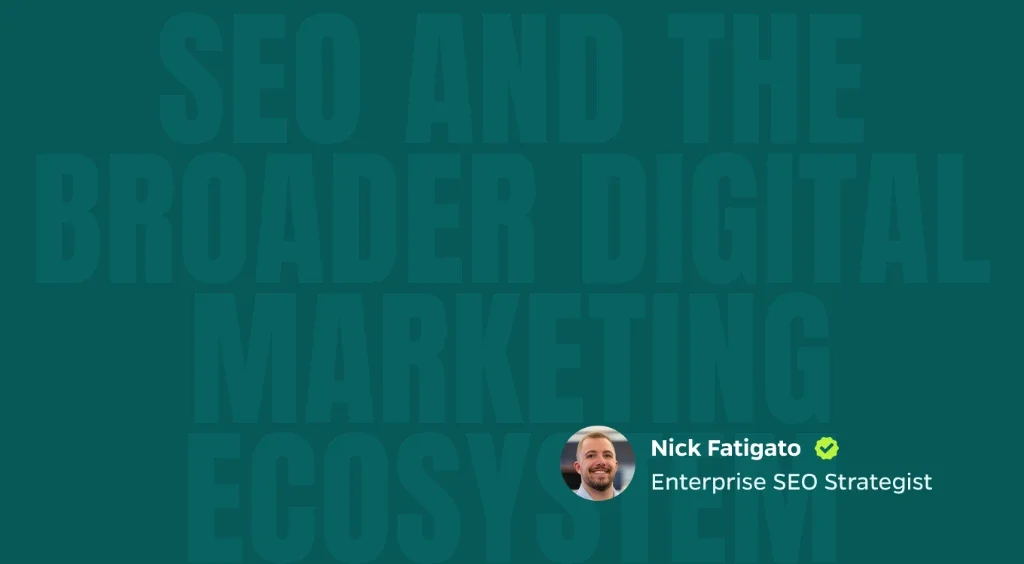
SEO and the Broader Digital Marketing Ecosystem
That’s a great question. And I think SEO automation when it comes to the digital marketing ecosystem. I think it’s just a staple of where we’re at today. This is simply something that’s part of our work life now. If you’re not using tools and some sort of automations to streamline your processes and optimize your processes, then you’re really just behind the 8 ball in the industry. And you’re kind of tying your own hands behind your back, because there are so many ways that we can use technology to assist our processes. So when you think about digital marketing, SEO is just one aspect of that. But automation is everywhere. Automation is in the paid realm. Automated bidding strategies is just like the main example. But you know, automation can come all over the place. There might be ways to automate, just like your overall operational processes. SEO automation is just a small element of SEO in itself. But SEO is also another large element of digital marketing. And I think automation and all these tools that we have, AI is certainly the new normal and something that will be fully integrated into our lives and the digital marketing ecosystem for as long as we’re working on SEO.
Automation is a powerful aid, but it’s no replacement for strategy, creativity, or user understanding. Know what to automate, what to own, and when to say no.
Key Takeaways
SEO automation is powerful, but it’s not the whole solution.
- Automate the repeatable. Let tools handle audits, reporting, and data collection so you can focus on strategy and creativity.
- Keep strategy and content human. Google values lived expertise and authentic voice, which are things automation can’t replace.
- Take a hybrid approach. Use AI and automation to enhance efficiency, but always layer in personal insights, brand context, and critical thinking.
Automation makes SEO faster and smarter, but your expertise is what makes it credible and impactful.


